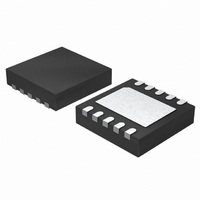ISL6298-2CR3Z Intersil, ISL6298-2CR3Z Datasheet - Page 14

ISL6298-2CR3Z
Manufacturer Part Number
ISL6298-2CR3Z
Description
IC CHARGER LI-ION 4.2V 3X3 10DFN
Manufacturer
Intersil
Datasheet
1.ISL6298-2CR4Z.pdf
(17 pages)
Specifications of ISL6298-2CR3Z
Function
Charge Management
Battery Type
Lithium-Ion (Li-Ion), Lithium-Polymer (Li-Pol)
Voltage - Supply
4.3 V ~ 6.5 V
Operating Temperature
-20°C ~ 70°C
Mounting Type
Surface Mount
Package / Case
10-VFDFN Exposed Pad
Lead Free Status / RoHS Status
Lead free / RoHS Compliant
Available stocks
Company
Part Number
Manufacturer
Quantity
Price
Company:
Part Number:
ISL6298-2CR3Z
Manufacturer:
INTESIL
Quantity:
395
V
V
V
TMAX+
The N-channel MOSFET Q
gate of Q
FAULT pin outputs a logic low signal, Q
drain outputs a low signal as well. When FAULT is high
impedance, R
power is removed, the Q
the Q
NTC Thermistor Circuit Design
As shown in Figure 21, the thresholds for the NTC circuit are
formed by the internal voltage divider. Since the external
circuit is also a voltage divider, the accuracy of the bias
voltage, that is, the V2P8 pin voltage, becomes not critical.
Figure 25 shows the typical values of the thresholds as
percentages of the V2P8 pin voltage.
The NTC thermistor resistance is dependent on the ambient
temperature. Reducing temperature leads to the increase of
the resistance as well as the TEMP pin voltage. When the
TEMP pin voltage exceeds 50.3% of the bias voltage, an
under-temperature fault is triggered. On the other hand, if
the TEMP pin voltage is lower than 12.5%, an over
temperature fault occurs. The TEMP pin voltage has to fall
back to the 14.5% to 42.9% range for the fault be cleared, as
shown in Figure 25.
The ratio, K, of the TEMP pin voltage to the bias voltage is:
Using the ratios at cold and hot temperature limits, as shown
in Figure 25, resulting in:
and
V
TMAX
TMIN-
TMIN
FIGURE 25. CRITICAL VOLTAGE LEVELS FOR TEMP PIN
R
(50.3%)
(42.9%)
(12.5%)
(14.5%)
Under
Temp
Temp
U
Over
1
K
100%
R
------------------- -
R
drain stays high.
0
=
COLD
=
HOT
1
1.012 R
--------------------- -
R
is connected to VIN or the V2P8 pin. When the
T
R
+
1
T
=
R
⋅
pulls the Q
U
7.08
COLD
1
gate voltage is also removed, thus
1
1
drain to high. When the input
14
buffers the FAULT pin. The
1
is turned on and its
Voltage
TEMP
(EQ. 6)
(EQ. 7)
(EQ. 8)
Pin
ISL6298
where R
values at the cold and hot temperature limits respectively.
It is usually difficult to find an NTC thermistor that has the
exact ratio given in EQ. 7. A thermistor with a ratio larger
than 7.08, that is:
can be used in series with a regular resistor to form an
effective thermistor that has the right ratio, as shown in
Figure 26. With the series resistor R
written as:
Once the thermistor and the temperature limits are selected,
R
and
To summarize, the NTC thermistor circuit design requires
three steps:
The following is a design example. The charger is designed
to charge the battery with the temperature range from 0°C to
55°C. The 10kΩ NTC thermistor NCP15XH103F03RC from
Murata (http://www.murata.com) satisfies EQ. 9. The
resistance table is given in Table 3. The typical resistance at
1. Find an NTC thermistor that satisfies EQ. 9. The
2. Calculate the series resistance according to EQ. 11.
3. Calculate the pull-up resistance according to EQ. 12.
R
S
R
S
and R
U
temperature limits are determined by the application
requirement.
R
----------------------------------
R
=
FIGURE 26. EFFECTIVE NTC THERMISTOR CIRCUIT
S
=
S
R
------------------- -
R
------------------------------------------------------
+
R
+
1.012
COLD
COLD
COLD
R
HOT
R
U
ISL6298
COLD
HOT
can be calculated using
⋅
≥
–
6.08
(
and R
R
7.08
7.08R
=
S
+
7.08
R
HOT
HOT
COLD
V2P8
TEMP
GND
are the NTC thermistor resistance
)
R
S
R
R
T
U
S
, EQ. 7 can be re-
March 9, 2006
(EQ. 10)
(EQ. 11)
(EQ. 12)
FN9173.4
(EQ. 9)












